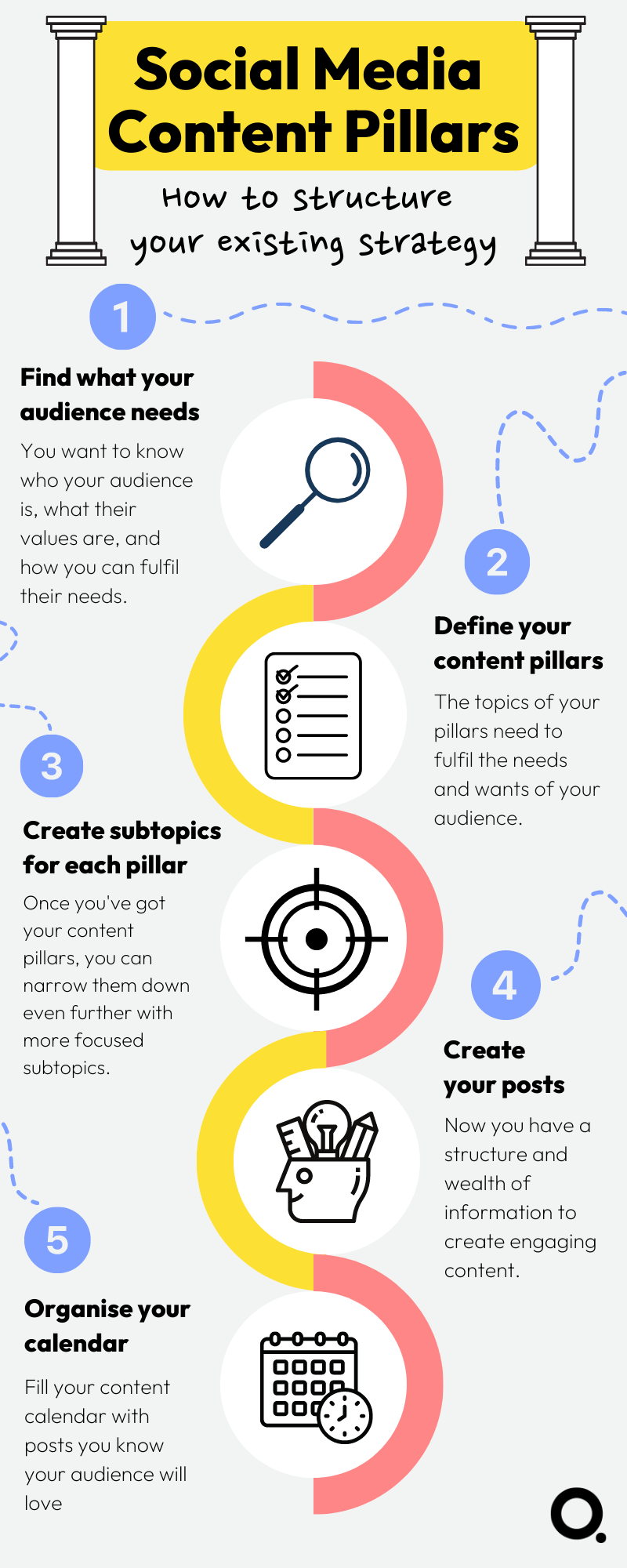Like it or not, social media and how you use it plays a big part in a successful marketing strategy. The occasional post once a month or a meme here and there won’t cut it. You need a well-planned content strategy. Because you can bet your competitors have one.
Simply put, if you don’t understand content pillars and how they relate to your brand then you’re selling yourself short. In this blog, I’m going to tell you exactly how you can understand what your audience wants, and take your social media to the next level.
- What are content pillars?
- Why are content pillars useful for social media?
- How to create content pillars
- Content pillars examples

What are content pillars?
Content pillars, sometimes referred to as content buckets, are the core topics or themes of your brand on social media. These are the subject areas in which you would like your brand to be an authority. With your content pillars defined, you can then create several subtopics for each pillar. This will help you really focus on the specialist areas that interest your audience. Once you know your pillars and subtopics, it makes it much easier to create relevant content which your users will value and engage with.

Content pillars are unique to each individual business, but they should align with the core values and message of your brand. That way, it will be easier to create content, fill your content calendar, and develop a deeper level of trust with your customers.
You might be tempted to create these content pillars yourself based on what you instinctively feel is right, but actually researching what resonates with your target audience and using those results to develop your pillars will give you a better idea of what is going to be valuable for your audience.
Why are content pillars useful for social media?
3 main reasons:
- You can create content more easily
- You can organise your social media content calendar
- You can ensure optimal brand consistency
Create content more easily
If you don’t have any content pillars the world is your oyster. There’s a blank page in front of you with no direction on the type of content that might work. Cool, you can let your creative juices flow forth. Or, more likely, you’ll create something that doesn’t align with your brand. Having complete freedom can be a blessing or a curse, and when it comes to social media marketing without content pillars, it’s a curse.
Take the infographic above as an example. The core pillar is nutrition, which has then been broken down into five subtopics:
- Intuitive eating
- Meal planning
- Resources about nutrition
- Nutrition labels and ingredients
- Anti-inflammatory foods
All of those different topics aren’t going to lend themselves to every form of media. Posts about anti-inflammatory foods may work best as infographics. Nutrition labels and ingredients might be best served with simple text. Once you know what you’re talking about. It’s easier to know how to talk about it. This will speed up content creation and improve brand consistency.
With your pillars as your guiding star, you now have more creative energy to put into creating the best pieces of content for your brand.
Organise your social media content calendar
Now you know exactly what content you’re producing, you can go ahead and fill your content calendar. If we use the meal planning subtopic for the above list, we can schedule all meal planning posts for a Friday. Your audience now has the weekend to buy the necessary ingredients and prep the meals you posted.
While we’re at it, let’s add posts about anti-inflammatory foods on Sundays, when your customers may be nursing a sore head and looking for something to perk them up.
Using just two subtopics from a single content pillar, we’ve got posts scheduled for two days of the week. Add in more pillars, all with their own subtopics and you can see how quickly and easily you’ll be able to fill your calendar.
And what’s better than a full content calendar? That’s right, absolutely nothing.

Brand consistency
It’s 2022. Every brand has a social media presence, and social media users are savvier than ever. People will choose to follow you on social media because you fulfil a need or satisfy a particular pain point. If your content pillars are well defined and utilised, you’ll be able to meet those needs more easily.
Without content pillars, you will have no idea what the needs of your users are or if you’re meeting them. As a result, your brand and tone of voice will appear disjointed. Your audience may become confused, and at worst, you could lose them.
How to create content pillars
You know what your brand is about. You know its message, and tone of voice, so creating your own content pillar strategy should be fairly straightforward. But if you take into account the wants and needs of your users across all social media platforms, you’ll be able to create a content pillar strategy that really gives your users what they want.
The path to creating your pillars can be broken down into four steps.
- What are your brand’s personas?
- Audit your own content
- Keyword research
- Competitor research
What are your brand’s personas?
This is all about your brand’s audience, who they are, and what they want. You need to know who your audience is before you can start to figure out what they want from your brand. There are several questions you can ask to find your customers’ persona to help define your content pillars.
- Who is my audience?
- What social media platforms are they using?
- What kind of content do they prefer?
- What topics are my target audience interested in?
- What values are important to my target audience?
This isn’t an exhaustive list. There will no doubt be questions specific to your brand, but they’re a great place to start.

The answers to some of the above questions may be quite far-reaching if your brand has a wide and diverse audience. They’ll be spread across several social media channels. Some (millennials, probably) will prefer Instagram reels to TikTok (Gen Z or Generation Alpha). Some will prefer the visual richness provided by infographics to plain text. All of which you can explore in the next step.
Audit your own content
Now you have a great base of research for creating your own content pillars, but a little more work can make them even better. As a social media marketer, you already have access to a wealth of information; your brand’s previous social media posts.
Look at the posts you’ve already created for your brand and see what worked and what didn’t. If there are specific types of posts that worked (or didn’t), you know you can include them (or not) in your content pillars. Has a particular hashtag stopped working recently? Think about changing it.
You should regularly be keeping an eye on how your content is performing. Something that works this week might not work one month down the line. If something stops working consistently, perhaps it’s time to rethink that particular pillar or subtopic. Social media isn’t static, and your content pillars shouldn’t be either.
At this point, it’s worth noting that your content pillars won’t be the be-all and end-all of your content strategy, and it’s still important to be able to react to social media trends or world events. But with your pillars in place, you’ll have a framework for your reactionary content.
Keyword research
You probably associate keyword research with SEO, but it can also be useful in social media marketing. I mean, when you think about it, each social media platform is its own search engine to a certain degree. Unfortunately, each social media platform has its own ecosystem, meaning keyword research is different in each. Let’s look at Instagram. On a very basic level keyword research on Instagram is pretty simple and something you probably use already. Hashtags.
They might seem a little old school, but they can really help push your content to a wider audience. Thankfully Instagram makes it easy to find hashtags via the search bar and even lets you know how popular each one is on the results page.

Once completed, your findings can help define your content pillars. You know what people are searching for on Instagram, and you know which hashtags are popular. Just be sure to double-check the ones you want to use. They might mean something completely different to people outside your audience!
Competitor research
Is there a brand out there you’re competing with? Head over to their social media channels and have a nosey. What kind of content are they posting? Are they posting high-quality content? Just memes? Are they using different hashtags to you?
Of course, you’ll be restricted in the amount of information you will be able to gain. But if they’re doing something that consistently engages their users, it might be worth thinking about how you could repurpose their strategy to be successful for your own content marketing objectives.
You don’t have to stick to direct competitors. If you think there are other brands outside your market with a similar customer demographic, have a look at what they’re doing as well. You’ll get just as much information about what social media posts are working for them. And if you end up in a completely different market, you may also be exposed to completely new content ideas you’ve never thought of before.
Content pillars examples
Okay, now we know what content pillars are, how they can help us, and how to create them. So let’s create a fictional company and with it the content pillars they would employ in their digital marketing.
Let’s create a company that makes vegan meat substitutes. We’ll call it, erm, Veat.
Now we know our company, we can pretend we’ve got our personas, had a sneak around our competitors’ social feeds and had an in-depth audit of our own content. We’ve got a good idea of what works and what doesn’t. We know what our users want, so we know what our content pillars will be.
- Highlighting how environmentally friendly our products are compared to animal products.
- Highlighting the level of animal suffering in the meat industry.
- Sharing recipes using our product. These could be produced in-house or via user-generated content.
- Highlighting the health benefits of Veat compared to meat.
Let’s use these content pillars to create some subtopics, which will be incredibly helpful when it comes to content creation.
“Veat” – social media content pillar subtopics
If we look at the first pillar, we can immediately see several subtopics to delve into:
- Water usage
- Land usage
- Emissions created
- Raw materials needed
Think about your personas and what your audience wants from you. It might be that not all of your audience cares about the environmental impact of your food. If, through your persona research, you found your younger users are more concerned with environmental issues, use that information to your advantage. Almost half of TikTok’s users are under 25, so focus your environmental posts on TikTok or where your younger users are.
We know people following our brand like food and cooking, so for the third pillar we have more subtopics.
- User-generated recipes
- Themed recipes (Think Christmas or BBQ)
- Professional recipes
- Hashtags, such as #meatlessmondays
This content pillar and its subtopics are likely to cover a wide range of your audience, so you won’t need to worry too much about the format of your content, and you’ll have a bit more freedom to create something that appeals to most of your users.
As mentioned before, these content pillars and their subtopics aren’t static. The above pillars might work for a while, or certain subtopics might prove more popular than others. Always check your social media metrics to see if your content pillars are still working as well as they could be.
Content pillars and Instagram content
TikTok may have captured the younger demographic, but Instagram is still the second most popular social media platform behind Facebook. And it’s still the home of influencers. One of the reasons for its continued popularity is that it’s constantly evolving, just as your content pillars should be. But why are we talking about Instagram and content pillars? Because once you’ve defined your brand’s content pillars, you can also use those to figure out which type of content will be best to use.
Instagram has stories, which can be used if you need to react to something that is happening at that moment. They can also be used to interact with your audience and work particularly well if user-generated content is a big part of your social media strategy or a particular marketing campaign. Did a customer post an Instagram story full of praise for your product? Repost it to your story as a great testimonial!
Specific content is best used in certain formats. If Veat wanted to post an infographic about the amount of water they use compared to animal agriculture, an Instagram carousel would be the perfect medium to use, rather than Instagram stories. Likewise, Instagram reels are the perfect place to upload a short teaser video for a new product.
Conclusion
The use of content pillars in your brand’s social media strategy will really take your marketing to the next level. Without content pillars, your social media strategy may have looked more like a scattergun approach. But with the introduction of your well-defined content pillars and subtopics, your posts will now be hyper-focused and engaging to your audience.
Don’t rest on your laurels. Constantly review your own content and that of your competitors, and you’ve got yourself a winning social media strategy.





